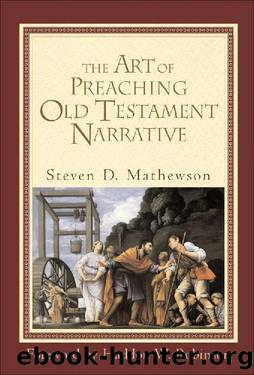The Art of Preaching Old Testament Narrative by Steven D. Mathewson

Author:Steven D. Mathewson [Mathewson, Steven D.]
Language: eng
Format: epub
ISBN: 9781585588442
Publisher: Baker Publishing Group
Published: 2002-04-01T08:00:00+00:00
Delivery
In any preaching event, how you use your voice is important. You have the opportunity for vocal variety and punctuation in your pitch, punch (volume), progress (rate of delivery), and pause.[7] Whether you preach from a first-person or third-person perspective, you will have the opportunity to deliver lines from characters in the story. Use a combination of these variables to convey the emotion of the speech. As a general rule, youâre not being as dramatic as you think you are. For example, if you are moving from loud to soft, it may seem to you like the volume drops from level 9 to level 2. When your audience hears it, however, or when you listen to yourself on tape, the volume level only drops from level 9 to level 6. The pause that seems like four seconds to you only takes one second. So donât be afraid to overexaggerate your contrasts.
When you deliver your story, use large gestures. Large gestures help preachers get rid of nervousness. They also add realism to your story. Storytelling lends itself to gesturing more than any other form of communication. Using your hands, you can toss wheat into the air with a pitchfork. You can draw a bowstring and shoot an arrow. You can point to Jerusalem or Bethlehem or a well or the field of Boaz. You can shield the sun from your eyes.
There are a couple of other things you can do to help your audience visualize the scene youâre constructing. Remember to keep Jerusalem or Shechem at the same spot throughout the whole sermon. If you point to your left at the imaginary city of Jerusalem, you must always point to your left when indicating Jerusalem. If you point to your left the first two times and to your right the third time, you will create visual confusion. Furthermore, remember that your congregation sees everything backwards. When you draw a line from left to right, your audience sees a line being drawn from right to left. So if you are trying to construct a timeline and talk about the past, you will want to start the line on the congregationâs left, which happens to be your right.
Eye contact is also important. Haddon Robinson notes, âAlmost without exception, a congregation will not listen attentively to speakers who do not look at them.â[8] He counsels looking at and talking with one listener at a time for a second or two. Look that listener in the eye, then turn to someone else. The goal is not simply looking at listeners but talking with them.
However, storytelling is the one time a preacher may momentarily gaze over the audience and look into space. As Fred Craddock observes, âA good storyteller seldom looks at anyone.â[9] A preacher may want to look beyond the audience when relating a dialogue between two characters. In a first-person narrative, the preacher might look beyond the listeners when delivering the reminiscences or reflections of a character in the story. Essentially, you are looking beyond the audience to the scene you are imagining.
Download
This site does not store any files on its server. We only index and link to content provided by other sites. Please contact the content providers to delete copyright contents if any and email us, we'll remove relevant links or contents immediately.
Evangelism In a Skeptical World: How to Make the Unbelievable News About Jesus More Believable by Sam Chan(196)
The Witness of Preaching, Third Edition by Long Thomas G(155)
Evangelism Without Additives by Jim Henderson(155)
How to Preach a Dangerous Sermon by Frank A. Thomas(149)
Emotionally Healthy Discipleship by Peter Scazzero(148)
Transforming Fellowship: 19 Brain Skills That Build Joyful Community by Chris M Coursey(145)
The Art of Preaching Old Testament Narrative by Steven D. Mathewson(128)
Sermons of St. Alphonsus: For All the Sundays of the Year by St. Alphonsus Liguori(122)
Contagious Disciple Making: Leading Others on a Journey of Discovery by David Watson & Paul Watson(114)
Smart Sermon: How to Preach Intelligent Biblical Sermons that Transform Lives by Reimar Vetne(108)
Captured Fire: The Sunday Homilies, Cycle B by Krempa S. Joseph(104)
How to Write and Preach a Sermon: Practical Advice for the New Preacher by Christopher Bentliff(104)
Reciprocal Missions: Short-Term Missions that Serve Everyone by Steiner Phil & Schuetze DJ(93)
Christian Missionary Engagement in Central Nigeria, 1857â1891 by Femi J. Kolapo(87)
Determining the Form: Structures for Preaching (Elements of Preaching) by O. Wesley Allen(87)
Preaching Better by Ken Untener(87)
Outreach and Renewal by McSherry James(84)
Recovered by Robby Gallaty & Rob Suggs & David Platt(73)
